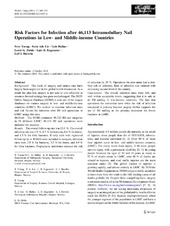| dc.contributor.author | Young, Sven | en_US |
| dc.contributor.author | Lie, Stein Atle | en_US |
| dc.contributor.author | Hallan, Geir | en_US |
| dc.contributor.author | Zirkle, Lewis G. | en_US |
| dc.contributor.author | Engesæter, Lars B. | en_US |
| dc.contributor.author | Havelin, Leif Ivar | en_US |
| dc.date.accessioned | 2014-02-10T12:54:46Z | |
| dc.date.available | 2014-02-10T12:54:46Z | |
| dc.date.issued | 2013-02 | eng |
| dc.Published | World Journal of Surgery 37(2): 349-355 | eng |
| dc.identifier.issn | 0364-2313 | |
| dc.identifier.uri | https://hdl.handle.net/1956/7778 | |
| dc.description.abstract | Background: The fields of surgery and trauma care have largely been neglected in the global health discussion. As a result the idea that surgery is not safe or cost effective in resource-limited settings has gone unchallenged. The SIGN Online Surgical Database (SOSD) is now one of the largest databases on trauma surgery in low- and middle-income countries (LMIC). We wished to examine infection rates and risk factors for infection after IM nail operations in LMIC using this data. Methods: The SOSD contained 46,722 IM nail surgeries in 58 different LMIC; 46,113 IM nail operations were included for analysis. Results: The overall follow-up rate was 23.1 %. The overall infection ratewas 1.0 %, 0.7 %for humerus, 0.8 %for femur, and 1.5 % for tibia fractures. If only nails with registered follow-up (n = 10,684) were included in analyses, infection rates were 2.9 % for humerus, 3.2 % for femur, and 6.9 % for tibia fractures. Prophylactic antibiotics reduced the risk of infection by 29 %. Operations for non-union had a doubled risk of infection. Risk of infection was reduced with increasing income level of the country. Conclusions: The overall infection rates were low, and well within acceptable levels, suggesting that it is safe to do IM nailing in low-income countries. The fact that operations for non-union have twice the risk of infection compared to primary fracture surgery further supports the use of IM nailing as the primary treatment for femur fractures in LMIC. | en_US |
| dc.language.iso | eng | eng |
| dc.publisher | Springer | eng |
| dc.relation.ispartof | <a href="http://hdl.handle.net/1956/7782" target="blank">Orthopaedic Trauma Surgery in Low-Income Countries. Follow-up, Infections and HIV</a> | eng |
| dc.rights | Attribution CC BY | eng |
| dc.rights.uri | http://creativecommons.org/licenses/by/3.0/ | eng |
| dc.title | Risk Factors for Infection after 46,113 Intramedullary Nail Operations in Low- and Middle-income Countries | en_US |
| dc.type | Peer reviewed | |
| dc.type | Journal article | |
| dc.description.version | publishedVersion | en_US |
| dc.rights.holder | Copyright The Author(s) 2012 | |
| dc.identifier.doi | https://doi.org/10.1007/s00268-012-1817-4 | |
| dc.identifier.cristin | 1025734 | |
| dc.source.journal | World Journal of Surgery | |
| dc.source.40 | 37 | |
| dc.source.14 | 2 | |
| dc.source.pagenumber | 349-355 | |

